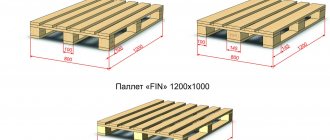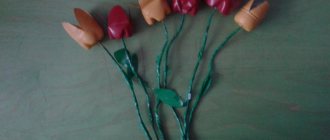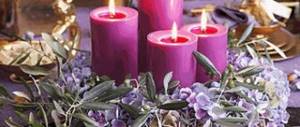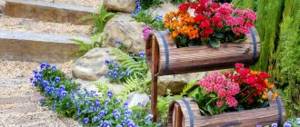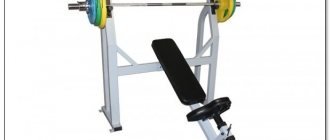Steps to prepare flower beds
Before you start planting flower beds, you need to know some recommendations, following which you can make neat and reliable flower beds.
Choosing a place to plant flower beds
The first step is to choose the right place where you can plant your flower beds. Assess the area of your garden or vegetable garden and choose the right place to plant flower beds. Assess the soil for moisture.
We recommend that you do not skip this point, since later, if any problems arise, you will not be able to move the flower garden to another place. Also, estimate the area of the territory and select the correct number of flowers.
Soil preparation
And so, after you have decided on the place to plant the flower beds, we prepare the selected soil. Note that this needs to be done in the spring.
First, you need to plow the desired area and fertilize it. If there were flowers in this area, they must be carefully removed and thrown away so that they do not interfere with the growth of new flowers.
If weeds are found on the soil, they should also be removed immediately. It is important that after removing the weeds, they should be thrown far beyond the flower garden area.
Preparing flowers
And so, now let’s move on to the final part of the preparation, namely preparation for planting the flowers themselves.
At the beginning of spring, you need to plant the desired flowers in small pots so that they take on their appearance and shape. In mid-spring, you can already transfer flowers from pots to the flower garden itself.
Vertical gardening - from idea to implementation, choosing options according to budget and attractiveness (photo + video)- Vertical flower beds - basic principles and rules for choosing plants and arranging a suburban area with your own hands
Decorative grass - 140 photos of original design. Review of the best varieties of grass for the garden, instructions, reviews, videos + gardener recommendations
If you have had a cold spring and the climate does not allow you to plant flowers at the right time, you can postpone this for 2-3 weeks. Such a period will not change anything radically.
Construction of a fence
To ensure that your flowerbed does not fall apart and has a shape, it needs to be fenced with a special border. You can do it in different ways.
You can buy special materials at a hardware store, or you can make a fence from what you have on hand.
For example, you can make a fence from plastic bottles. This method is good because almost all people have bottles. In addition, you do not pollute the environment, but use unnecessary bottles for good.
To create a beautiful and organic border, it is advisable to select bottles of the same shape and size. You need to bury them at the same distance from each other and securely fasten them together.
- Watering the site - types and types of systems, main differences and features, rules for selection and installation, as well as recommendations for operation
- Ornamental plants - 140 photo options. Review of the most popular plants with names and descriptions. Gardener's recommendations + reviews
Boxwood: planting, care, growing in open ground, propagation. Full description of the plant from A to Z. More than 100 photos of evergreen shrubs
These are the basic rules for preparing for planting flower beds, following which you will make very beautiful flower beds that will delight you.
Original flower beds
First of all, you need to decide what exactly you want to create on your summer cottage. If you have chosen a rustic style, then a flowerbed, for example, can be organized using old painted tires , as well as using decorations from an old bicycle.
In addition, compositions with ornamental trees and coniferous shrubs, which are distinguished by their sophistication, have gained enormous popularity. Such plants do not require any special care rules, and they look attractive all year round. If you still choose this option, then you must take into account that such plants must grow in an acidic environment.
In order to prepare the soil, it is necessary to use fallen pine needles, a small part of peat, and also turf soil. The resulting mixture is poured into pre-prepared recesses with a layer of 50 cm. It is not recommended to plant conifers close to each other, as they will grow greatly in the future. Such crops are most often complemented by boxwood, rhododendron or Erica.
Another very interesting option would be a flower bed of perennial plants. Currently, there are quite a few different planting schemes, where the location, color scheme, and flowering time are interestingly selected.
If you provide proper care to the plants, then such compositions will not need to plant new flowers every year. If you use the suggested tips, your garden plot will look quite presentable for several months of the year.
Types of flower beds
Looking at photographs of flower beds, you can’t help but notice that there are a great many varieties of flower beds.
We will present you the main and most popular types of flower beds:
- Flowerbed made of stones.
- Flowerbed made of bricks.
- Flowerbed made of concrete.
We will tell you about each type in more detail.
How to make a garden flowerbed at your dacha with your own hands?
A garden flowerbed at the dacha is created not through third-party devices, but through the competent planting of various flower plants. The fashionable trend in this direction today is the “natural”, natural flowerbed, in which not only bright, eye-catching flowers are planted, but also various herbs, cereals and other decorations that make the flowerbed three-dimensional.
To create a lush flower bed , you need to plant ornamental shrubs, ornamental grasses and bright annual flowers. Various herbs and grains are very useful, as they help the flowerbed to maintain its appearance at a time when some flowers are fading and others have not yet begun to bloom. And, for example, peonies or irises remain beautiful even after the flowering period due to their foliage alone.
Before planting plants, you should draw on paper a plan of what the flower garden will look like. And here you can show your imagination by making a flowerbed in the shape of a butterfly, circles or something else. Next, the form should be transferred to the ground and filled with soil.
Since for a spectacular appearance, when planting a garden bed, flowers and plants are located close to each other, they must be selected so that everyone has the same requirements. Soil, light, watering - everything must match.
What else should you remember when transforming your garden?
- You should trim and trim the plants on time and generally remember to care for them. Otherwise, the flower garden will not have the appropriate appearance.
- Faded or dead plants should be removed or trimmed.
- You should collect seeds, as this is much more convenient and cheaper than buying them again for the next season.
- Don’t forget to observe the flowerbed and take notes in order to remove all the disadvantages in the future and make it even more beautiful and ideal.
Garden flower beds are a type of planting that brings joy to all residents on the site for a long time, creating a real fairy tale around them.
Flower bed made of stones
This flower bed is quite decorative and is suitable for improving the landscape design of your dacha or vegetable garden.
It is worth noting that to properly execute a stone flower bed you need to have some skill and be very careful. But, if you do everything right, you will end up with a very impressive and beautiful piece of decor.
Living fence - the best ideas on what to make a hedge from at your summer cottage. Many photos of ready-made options with exclusive designs + instructions- Trimming bushes - the basics of choosing the right plants and forming the right shapes, selecting tools (photo + video)
Landscaping a site - basic principles and rules for creating a beautiful site with your own hands
As you already understand, the main feature of this flower bed is that you need to use stones as a fence for the flowers. We will describe to you the basic steps for making a flower bed from stones.
Choose the correct depth to lay your stones. It is important to ensure that the stones do not fall underground and do not protrude much above the surface.
Choose stones of the same size so that there is not much contrast. As for the shape, here you can experiment and fantasize with the design of your flower bed.
Place the stones tightly so that nothing wobbles. If you get any cracks, you can fill them with a special cement mortar.
We advise you to choose durable stones that do not form cracks, but if this happens, then lubricate the damage with sealant.
As for the choice of stones, here we will advise you to use basalt, slate and pebbles.
Flowerbed palette
From the name it may seem that such a flower bed is very difficult to make. But nothing like that. It couldn't be easier to do. We will need:
- plywood is not very thin, take a sheet;
- a couple of wooden blocks;
- hand cutter;
- varnish or paint;
First, let’s decide on a palette, then take a sheet of plywood and make a blank.
Next, we cut out 8 holes, for this we need a cutter. There is a hole in the center for brushes, the remaining 7 are for paint.
Next, we install the flower bed on stands; you can use bricks or blocks as stands. We insert flower pots into the hole and our flower bed is ready!
Brick flowerbed
The design of this flower bed is quite unusual. The main manufacturing tool is brick. You do not need to select any special type of bricks; ordinary bricks will do just fine.
So, first you need to mark the location of your flowerbed and dig a trench there on which you will lay bricks for the fence. Then, lay a certain number of bricks.
It is advisable to select bricks of the same shape so that your flowerbed looks aesthetically pleasing.
Then, the bricks should be firmly pressed so that they are tightly held together and do not move. After this, wait a few days and secure the bricks with a special cement mortar.
Ready! Your brick flowerbed is ready.
DIY flower beds made from scrap materials
I will deliberately not offer you complex options for flower beds, which only experienced craftsmen or landscape designers can do and require expensive materials. We will look at options for flower beds that can be made from scrap materials available at your dacha or that can be purchased at an affordable price at any building materials store.
DIY flower beds made from tires - simple options
Let's start with the most accessible and free material - used car tires. Every car enthusiast has them, and they will be happy to share them with you at any tire shop.
An important advantage of this available material is its very high durability and resistance to any climatic conditions.
Of course, I won’t suggest that you simply lay tires around the area, fill them with soil and plant flowers. It would be too primitive. It is necessary to somehow refine these tires or give them an unusual, original look. We will try to do both. Moreover, in order to cover a larger number of options, we will consider not only flower beds made from tires, but also flowerpots that you can make at the dacha with your own hands.
Let's start with the simplest again. To do this, you need to take a couple of old car bumpers, preferably wider ones, and paint them in a color unusual for this product. After this, place them on top of each other, filling them with earth one by one.
If you choose a color that will go well with other elements of the landscape design of the site, then such a simple flower bed will look good.
It's very easy to make a flower bed from tires cut in half.
To do this, use a large kitchen knife to cut the tires into two halves and paint them in different colors. The knife, of course, must be sharp, since cutting tires is quite difficult. Wetting the knife with liquid soap will help make the process easier.
To prevent the halves of the tires from moving apart, it is advisable to fasten them together from the inside before laying the ground. This can be done using wire, drilling holes, or strips of tin secured with not too long self-tapping screws.
A similar, but completely different-looking flowerbed can be made from the same halves of tires, but turned inside out.
To make the flower bed look more elegant, we make the edges of the tires curly using the same knife.
A small flower bed can be made in the same way without cutting the tire into two parts.
All that remains is to paint it in a color that best matches the flowers planted in it. Everything is simple, but it looks very good.
Now let's look at several options for flowerpots.
The simplest one consists of several tires of different diameters, painted in a color that imitates strawberries.
Agree, it looks quite original.
This “tea set” looks no less original.
I think they can decorate any cottage.
Other flowerpots, which I will give as an example, will be more difficult to make. Firstly, because rubber is quite difficult to cut, and secondly, only the weakest man can turn a tire inside out. But it's worth it. The flowerpots are elegant and durable. You just need to periodically refresh the paint.
It should be noted that in this case, not only the tire is used, but also an old, possibly slightly bent or cracked disk.
The operating procedure is as follows:
- we make a template of flowerpot petals from thick paper;
- put the template on the wheel and mark it with chalk or marker;
- cut out the petals with a knife;
- turn the wheel over;
- We stand on it with our feet and forcefully turn the tire out.
Now let's see what can come of this.
To conclude this section, I offer two examples of how you can still decorate your site by making original garden figures with your own hands from the same tires.
I will not describe the manufacturing technology of such and many other products, because this is a topic for a separate article.
Flower beds made from corrugated sheets - use leftovers
These flower beds can be made from the remains of corrugated sheets or metal tiles. If you covered the roof or sheathed the walls of any building, then you will definitely have scraps left over. Don't rush to throw them away. They can still be useful.
Here are some examples of flower beds made using such trimmings.
Profiled sheets and metal tiles are factory painted on both sides, so they will last for several seasons without maintenance. Making such flower beds is very easy and quick.
Cutting this material to the required size is not difficult. Along the waves, narrow strips of corrugated sheets can be cut with metal scissors. It is better to cut across with a grinder with a thin cutting wheel. Metal tiles also need to be cut with a grinder.
Slate flower beds - simple and durable
It is hardly worth purchasing slate specifically for these purposes. Typically, such flower beds are made from leftover material, and most often after covering the roofs with corrugated sheets or metal tiles. The remaining slate in large quantities is used for various purposes, including for making flower beds.
In addition to wave-shaped slate, there is also flat sheet slate. They usually line the walls of outbuildings. And at the same time, trimmings remain. You can make flower beds from them.
True, such flower beds do not have special aesthetics, but they are very durable.
If you paint them in a suitable color, they will, of course, look much better.
By the way, slate can be used to make not only flower beds, but also vegetable beds.
In addition, with the help of slate, you can limit the unhindered spread of shrubs on the site. For example, raspberries. To do this, you need to dig strips of slate of any type into the ground along the plantings to a depth of at least half a meter.
The easiest way to cut slate is with a grinder with a cutting wheel for stone (green label on the wheel) or a diamond wheel.
Just keep in mind that this will create a lot of dust. Therefore, be sure to wear a protective mask while working and choose a place to work where you can spray without damage!
Flower beds made from plastic bottles - everything goes into use
This material actually has a lot of advantages:
- durable, can last up to 50 years;
- there is a sufficient selection of initially painted bottles;
- different sizes and shapes of bottles, which expands the possibilities;
- versatility of use for different purposes;
- wide availability without financial investment;
- lightness and plasticity;
- easy to cut, allowing you to give it any shape.
From plastic bottles you can make not only flowerbed borders, but also charming garden figures that will decorate any backyard or garden plot.
Here are some examples of decorating flower beds using plastic bottles.
If you don’t have the opportunity to choose bottles of the desired color, you can paint transparent ones. To do this, you need to pour a little paint of the desired color inside (you can use acrylic), screw on the lid and shake. Thus, bottles painted from the inside retain their appearance for a very long time.
Before placing bottles in a flowerbed, you need to fill them with dry sand and screw on the caps. This makes the bottles better retain their shape and stay in the ground better due to the greater weight.
In addition to plastic bottles, you can also use glass ones. Check out a few ways to use them.
In addition to using plastic bottles in flower beds, you can make wonderful figurines of animals and insects with your own hands, as well as bright flowers that will “bloom” in your dacha as long as you want.
Here are some examples.
DIY flower beds made from boards - environmentally friendly and beautiful
Flower beds and flowerpots made of natural wood look very organic, naturally, being part of nature.
Of course, we are talking about boards or wooden blocks only planed and processed accordingly. That is, having a protective coating. Enameled boards are generally not used. Boards are used, impregnated with stain of the desired color and coated with varnish for external use.
Since wood quickly rots in direct contact with wet soil, decorative boxes are most often made, inside which suitable plastic containers with soil are placed in which flowers are planted. In this case, flower beds retain their original appearance for a long time.
If you still plan to load soil directly into a wooden flowerbed, then you need to take some measures to protect the wood from rotting. Treating the inner surface with antiseptics is probably not good for flowers. Therefore, it is better to cover the inner walls with tar or place a thick plastic bag inside. Well, or at least lay roofing felt inside.
It is very good if the tone of the covering of wooden flower beds matches other elements of the exterior on the site. That is, if a bench, pergola or wall of any building is approximately the same color. This will create a holistic picture in landscape design.
Flower beds made of stones - solid and durable
Natural stone is also an environmentally friendly material, like wood, unless of course it was mined in a uranium mine. Flower beds decorated with stones look very solid and monumental. The impression is that it was made to last.
Natural stone is indeed very durable and does not require any coating.
For these reasons, this material is often used in landscape design and, in particular, in the design of flower beds.
Here is the simplest example of using pebbles in a flower bed.
It looks good, but it was done, as they say, in a hurry. In this case, the pebbles will quickly spread across the flowerbed. Therefore, it is better to fasten it with cement mortar, as is done in the next photo.
The next version of a flower bed made of stone is also not difficult to manufacture, but it looks quite decent.
If you have flat natural stone in your area, consider yourself lucky. It also makes very good flower beds.
For the next flower bed, we used regular large stones that can be found in a rock quarry or in piles of gravel on concrete nodes.
I don’t know where to get the stones shown in the next photo, but they look quite original.
Multi-tiered flower beds with your own hands: photos of simple options
This type of flower beds has its advantages. This is a more original appearance, an opportunity to save space in the dacha by arranging flowers on several levels. You can more effectively combine flowers on different tiers.
The materials and methods for making multi-tiered flower beds can be used the same as in all previous flower bed options described above.
When preparing the ground for a multi-tiered flower bed, you need to take one feature into account. The soil under the second and third tiers should be denser than at the edges where the flowers will be located. If you completely fill the first tier with loose soil fertilized with humus and place the second tier on it and do the same with the third tier, then by the end of the season your flowerbed will settle and lose its shape and attractive appearance.
A few words should be said about the selection of flowers for multi-tiered flower beds. If you plan to plant different types of flowers in such a flowerbed, then you need to try to ensure that they bloom at the same time. Otherwise, it will not be beautiful if at some time the flowerbed looks like it is blooming only on some tiers.
Since the soil will remain wetter on the lower tier due to water runoff during watering and rain, flowers for this tier must be chosen that are moisture-loving. And for the upper tiers, flowers that tolerate dry soil are suitable.
The most suitable for multi-tiered flower beds are petunia, pelargonium, eschscholzia, begonia, calendula, hosta, nasturtium and others.
Flowerbed made of concrete
This flowerbed is also unusual. Its peculiarity is that the shape of this flower bed can be completely different.
Also, concrete is a very strong and durable material. Therefore, if you want to install a flowerbed for a long time that is not afraid of rain, then concrete will be the best choice for you.
But concrete also has its pros and cons. One of the main ones is that such a flower bed is quite heavy and takes up a lot of space. So, if you want to constantly change the location of your flower bed, this option is not suitable for you.
In addition, the design of this flower bed is rather faceless and inconspicuous. It is not suitable for bright gardens with bright and contrasting colors.
We do not recommend that you make professional concrete flower beds with your own hands, as this can cause complete failure.
It’s better to entrust this work to professionals who will make you a high-quality and good flower bed that will serve you for a long time.
Here are the main types of flower beds. We hope that you will make the right choice and determine which flower bed will look perfect at your dacha.
Flowerbed of continuous flowering
If you decide to set up a flower garden in front of the entrance to your house, then you probably want it to look quite attractive. The ideal option here would be to create a flower bed of continuous flowering.
Preparation
When creating a flowerbed with your own hands, you need to take into account several simple rules:
- Such a flower garden should contain both perennial and annual plants. It is also recommended to use shrubs.
- It is necessary to select plants with approximately the same requirements for lighting, humidity, and watering.
- There should be no aggressor plants in the flower garden. It is also undesirable to plant perennials in the flower garden, which are easily inseminated.
The next stage of creating a flower bed of continuous flowering involves drawing up a diagram on a simple sheet of paper. When drawing up a diagram, we determine its contours. After this, it is necessary to make a list of perennials that will be included in our flower garden, as well as determine their location.
The following flowers are suitable for spring:
- Tulip;
- Snowdrop;
- Narcissus;
- Crocus;
- Hyacinth;
- Scilla;
- Chionodoxa;
- Pushkinia;
- Muscari;
- Erantis;
- Primrose;
- Liverwort;
- Hellebore;
- Anemone;
- Saxifrage;
- Grouse;
- Daisy.
Summer is characterized by the largest selection of perennials:
- Lily;
- Aquilegia;
- Poppy;
- Delphinium;
- Cornflower;
- Bought;
- Phlox;
- Chamomile;
- Iris;
- Day-lily;
- Rudbeckia;
- Peony;
- Lychnis;
- Hosta;
- Carnation;
- Heuchera;
- Monarda;
- Bell;
- Bloodroot;
- Spurge;
- Sedum.
For autumn you can use the following flowers:
- Coreopsis;
- Chrysanthemum;
- Sunflower;
- Perennial aster;
- Goldenrod;
- Helenium.
It is also customary to identify groups of off-season plants that are attractive for a long time. These plants primarily include conifers: mountain pine, spruce, juniper. In addition, this also includes ornamental grasses: blue fescue, maned barley, miscanthus. For flower beds you can use all kinds of ferns, which are decorative throughout the summer.
The final list of plants will depend on the size of the future flower garden . But even if the size of the flower bed is quite large, there is no need to plant a huge number of different perennials; it is better to have a few of them, but each will occupy a larger area. In this way, you can avoid excessive diversity, which only complicates the perception of the entire flowerbed at once.
The resulting list should be divided into two groups:
- The first group will include plants that have a short growing season. Which plants mainly include spring bulbous flowers. In their place it is necessary to provide annual flowers. The ideal option would be to plant plants that form a large green mass from one root. The most common option is petunia. It can be planted away from the place where the bulbs are in the soil. When the petunia grows, it will completely cover it.
- The second group includes all remaining perennial plants. They are not able to spoil the overall appearance of the flower garden after flowering.
When you have finally decided on the list of perennial plants , as well as their growing characteristics, you can begin to place them on your plan. To do this, you need to number each perennial with a serial number starting from one. You are even allowed to cut out rectangles or circles from paper, numbering them. After that, they are laid out on a diagram, trying on different color distribution options.
When the diagram is completely ready, some places will still remain empty. You can fill these voids with the help of annuals. To do this, it is recommended to select unpretentious plants: tall and short marigolds, annual asters, nasturtiums, petunias, annual dahlias.
All of the above perennials have relatively low care requirements and are also varied in color. Thus, you can select plants that will organically combine with existing perennial plants.
Landing
Next, you can proceed directly to preparing the area in your garden. It is recommended to do this procedure in late summer or early autumn. The area for the flower bed must be dug well and all weeds removed. After this, the soil on the site should settle within two weeks , after which you can begin to plant rhizomes and bulbs of perennial plants.
If you do not have all the plants available, then planting them can be postponed until spring. But if you have already planted some plants, then they need to be marked with signs.
In the spring of next year, annual plants can be planted. It is recommended to plant seedlings, so that the required number of flowers can be planted in the allocated areas.
Thus, the flowerbed will be completely ready only in a year, when all the perennial plants have taken root and also expanded their root system.

